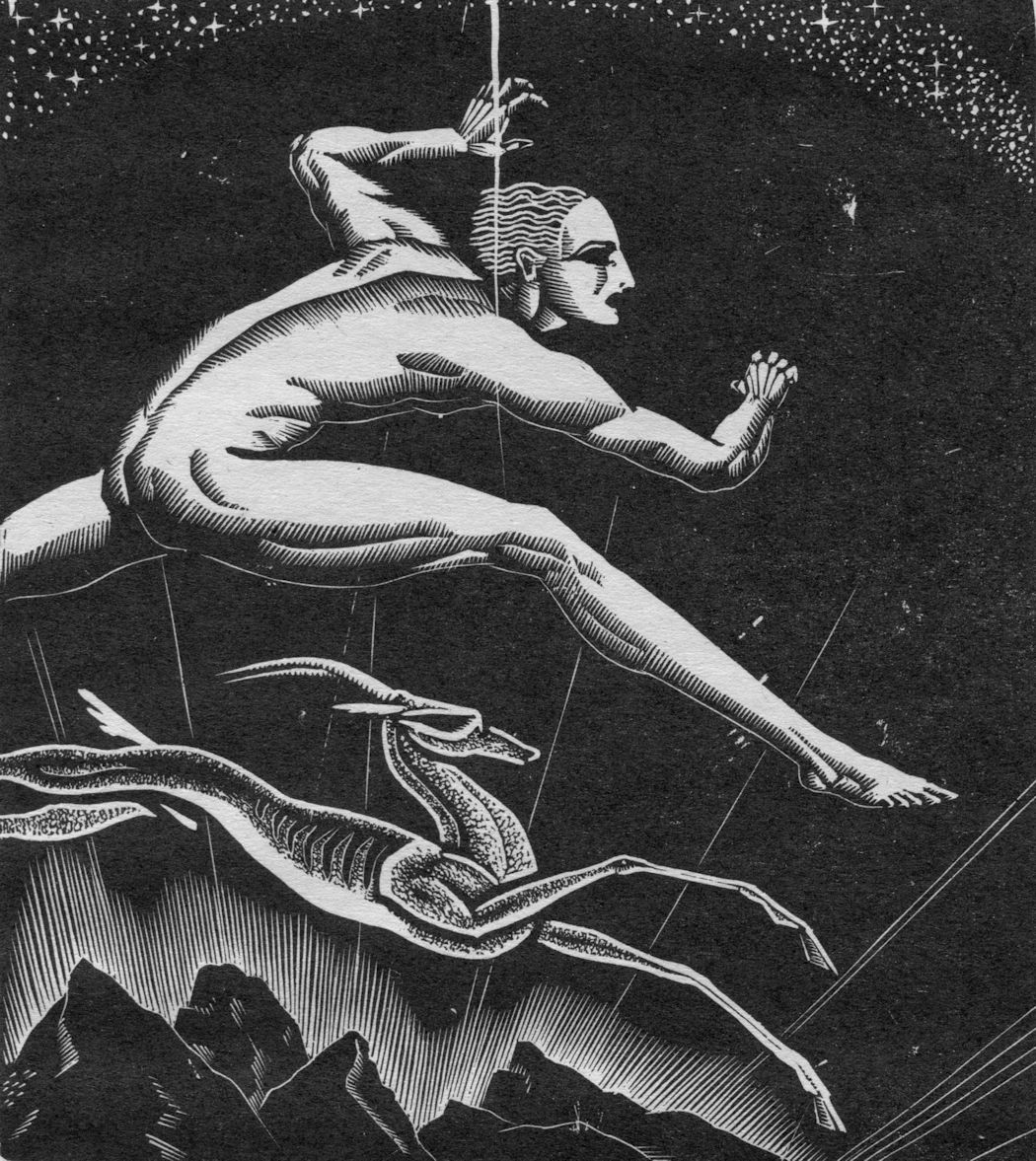John Alexander Noble (1913 - 1983)
John Alexander Noble (1913 – 1983)
Artist and lithographer John A. Noble was born in Paris, the son of American painter, John ("Wichita Bill") Noble, and spent his early years immersed in the company of his father and his peers. The family moved to New York in 1919, where attended the Friends Seminary in Manhattan. While there spent much of his free time on the tugboats of the McCarren Line, which towed wooden-hulled ships in New York Harbor, and during the summers between school years, Noble went to sea.
Following his graduation in 1931, Noble returned to France and studied at the University of Grenoble and upon his return studied for a year at the National Academy of Design. Until 1945, Noble worked as a seaman on schooners and in marine salvage and it was this experience that exposed him to the hulks of wooden ships scattered throughout the harbor, including the largest graveyard of wooden sailing ships in the world at the Port Johnston coal docks in Bayonne, New Jersey. He spent the remainder of his life portraying these vessels and documenting the working life of New York Harbor, working in a floating studio that Noble constructed from parts of a number of the abandoned vessels. His masterful lithographs document the passing of the age of sail and the gritty working life of the great harbor. He died on Staten Island.
The information that accompanies these images is drawn from the narrative commentaries of the artist himself, whose essays provide context for the world of harbor life that he inhabited for so many years. The catalog raisonné compiled and written by Erin Urban and titled Hulls and Hulks in the Tide of Time - The Life and work of John A. Noble, (1993, the John A. Noble Collection) is one of the most interesting and enjoyable books I have ever read.
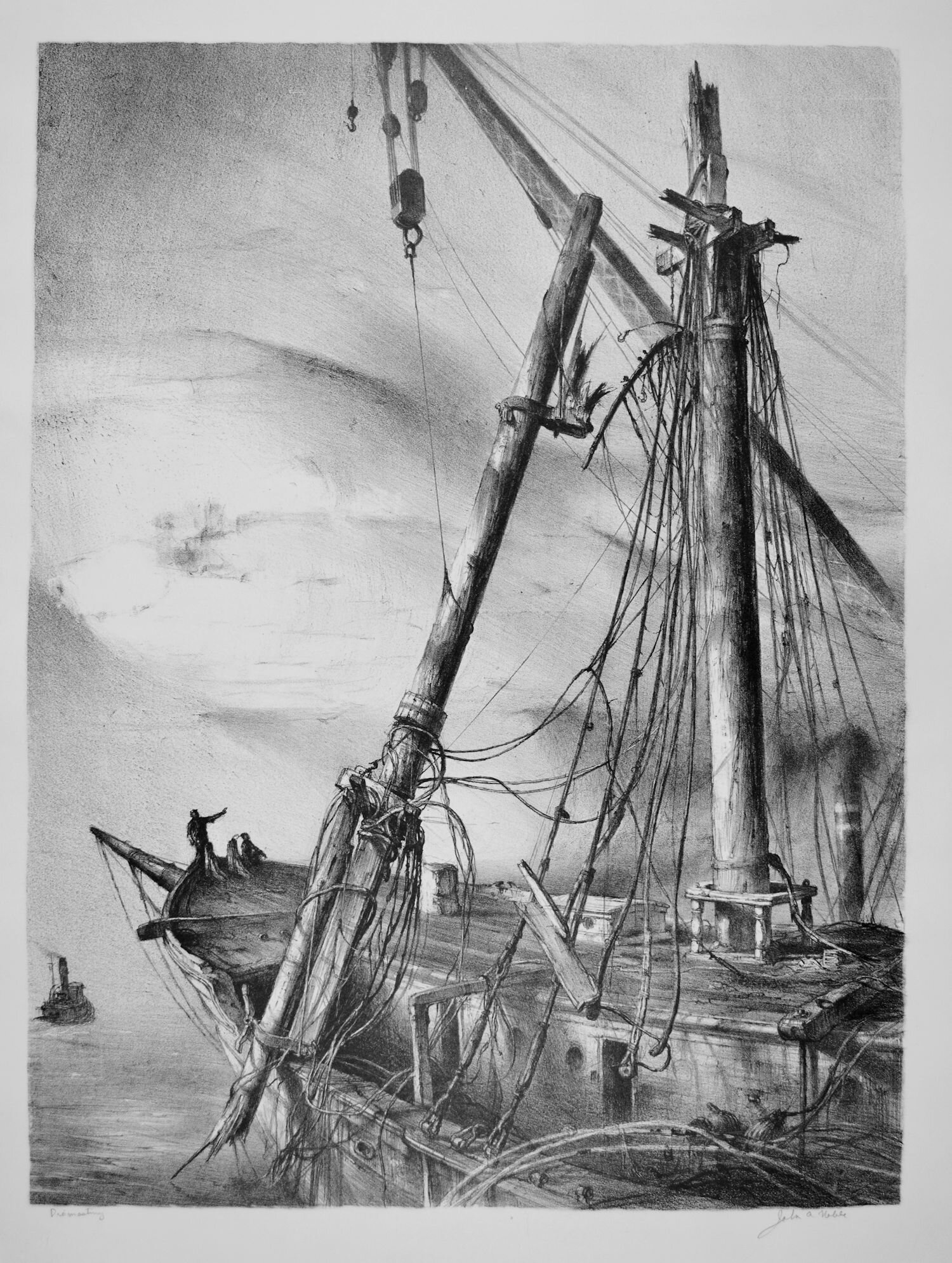
Dismasting
Lithograph, 1956; edition of 50. Image size 16¼” x 21¾”; sheet size 19” x 25-1/8”.
In a contemporaneous letter written by the artist, Noble comments “In the large lithograph (which shows McAllister’s great derrick the Victory in action), the wrecking crew clears away mere yard arms and upper masts - they are after the lower foremast, a thirty foot Douglas fir giant, if one can imagine such a stick nowadays.” These enormous masts were highly prized for use as fender booms for docks and dredges well into the modern era. A fine impression in near-fine condition.There is a short closed tear along he bottom edge of the sheet well away from the image. Urban 49.
SOLD
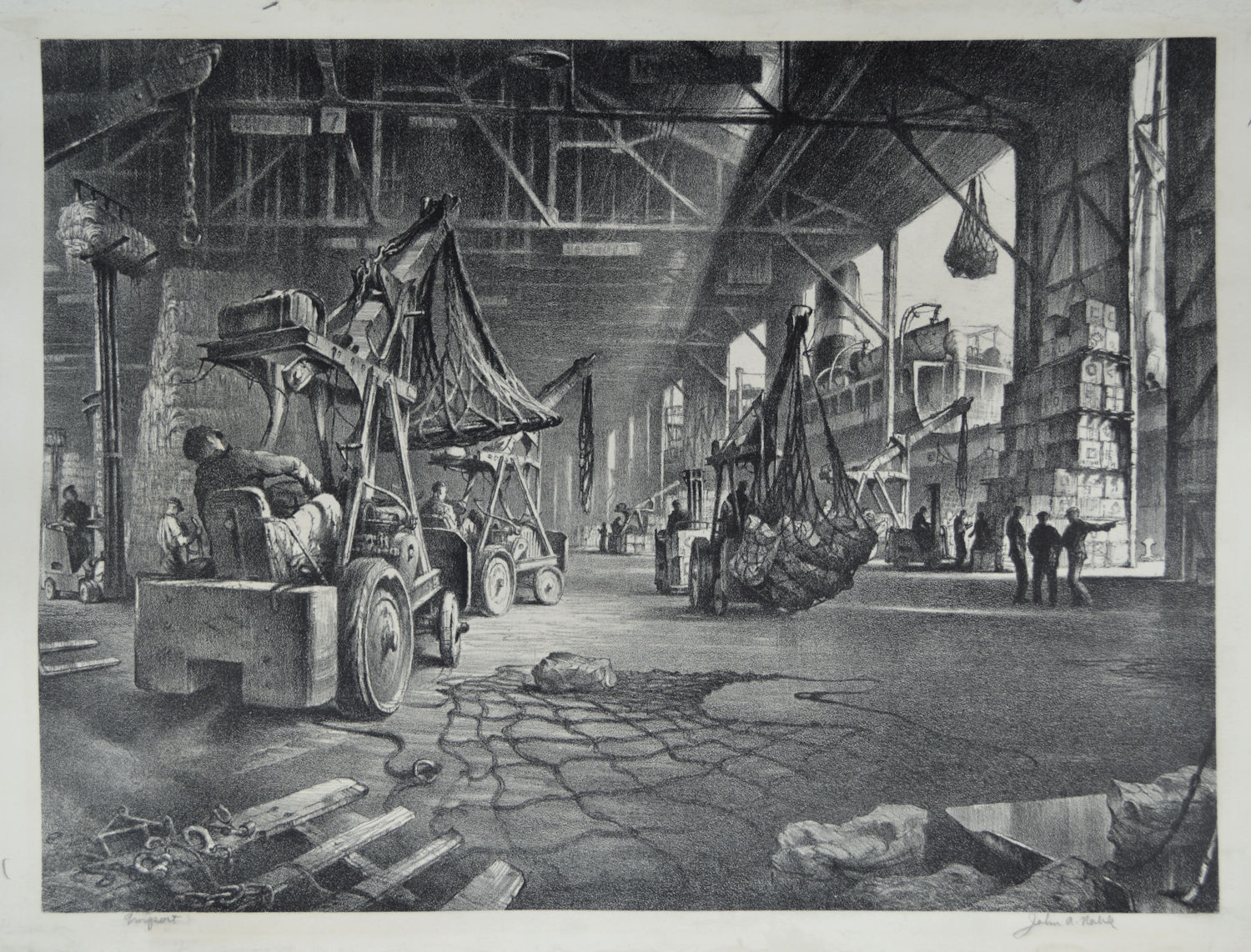
Import (Stevedores, Brocklebank Line Pier, Brooklyn)
Lithograph, 1951; edition of 50. Image size 15-13/16” x 11-11/16”; sheet size 17¼” x 13”. A beautiful impression in near-fine overall condition, with minor losses at edge of sheet, well away from sight area. This lithograph was commissioned by John T. Clark & Son, New York, which provided stevedore and operation services for Brocklebank Line, an English firm whose charter was granted by George III. Shown docked at the pier is its freighter Markhor. This print is in the Pennell Collection of the Library of Congress and the Mariners' Museum, New York. Titled and signed by the artist in the lower margin. Urban #21, Ames #21.
SOLD
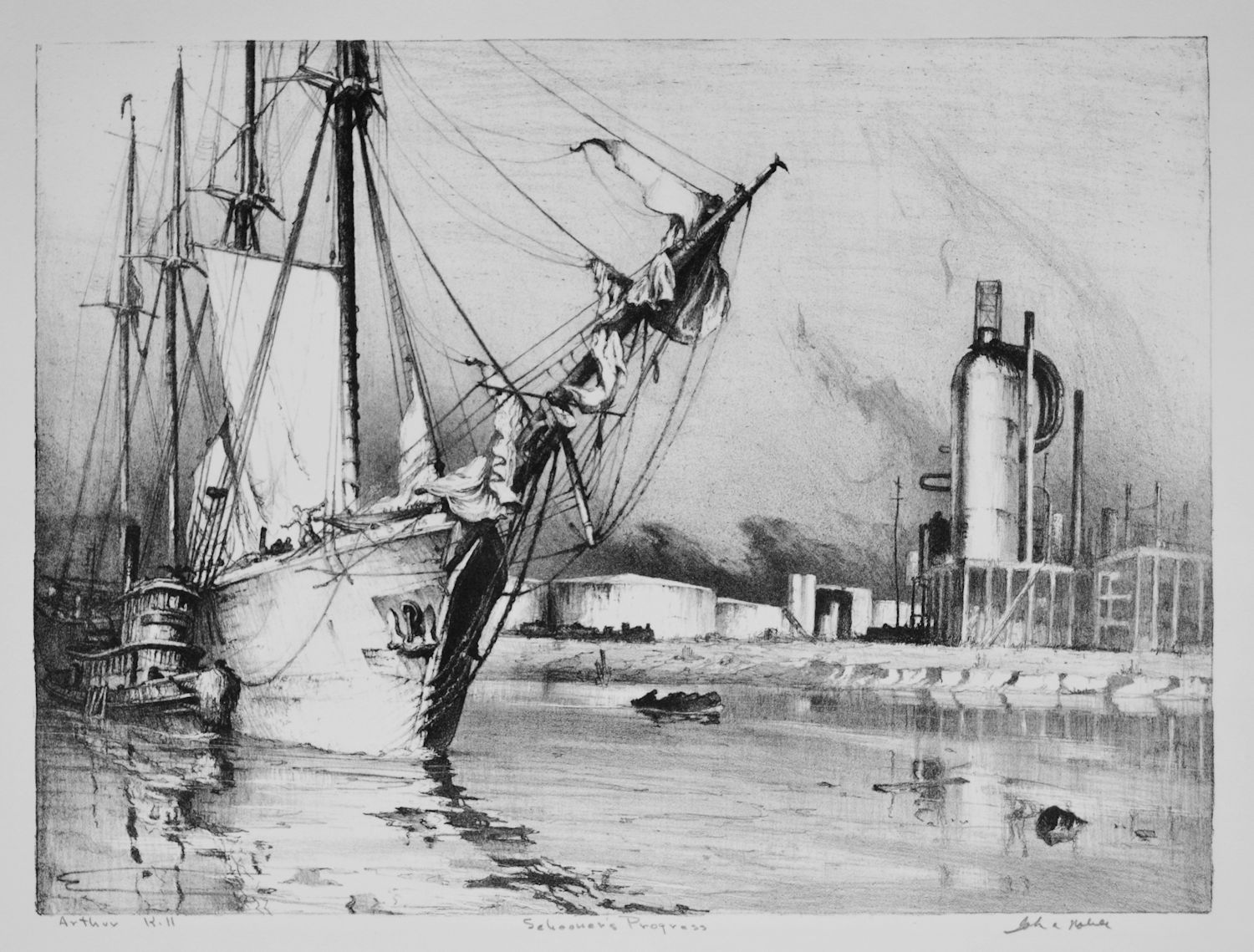
Arthur Kill
Lithograph on BFK Rives, 1947; edition of 200. Image size 15-7/8” x 11¾”; sheet size 19-7/8” x 15-7/8”. From the series “Schooner’s Progress”. Titled and signed in pencil by the artist. Fine condition with minor adhesive remnants at the uppermost edge of the sheet . Urban 7.
$875
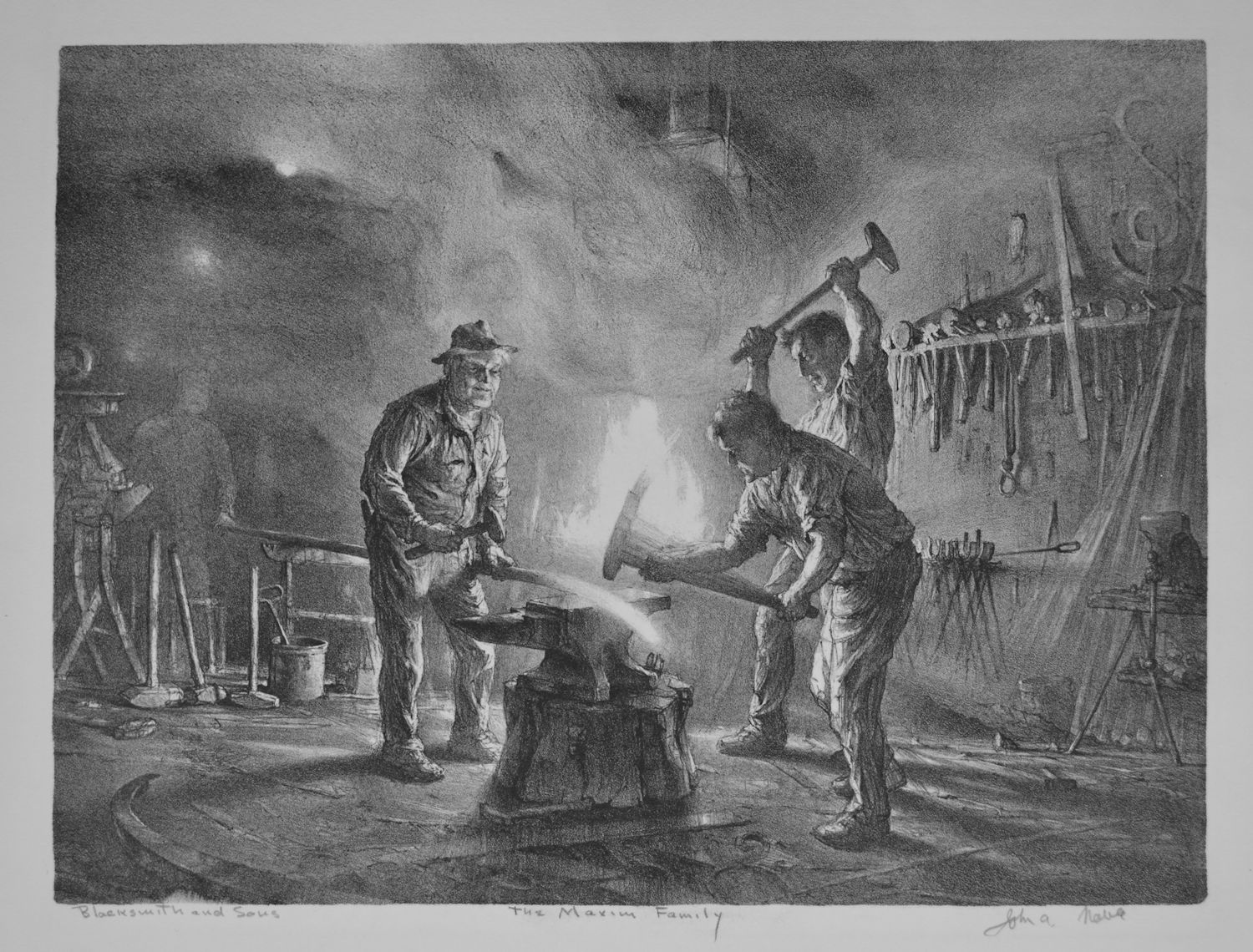
Blacksmith and Sons (The Maxim Family)
Lithograph on wove paper, 1964; edition of 200. Image size 16-1/8” x 12-1/16”; sheet size 19-7/8” x 16”. Titled and signed in pencil by the artist in the lower margin. This lithograph was commissioned by Joseph and Walter Maxim, proprietors of the Bayonne General Iron Works, Bayonne, New Jersey. Pictured in the foreground are patriarch John Maxim and his two sons, Joseph (sledge aloft) and Walter (sledge descending). The artist’s son Allan, who worked for the Maxim family, stands in the background shadows left. A fine and expressive portrait of a greatly diminished craft. Urban 53.
$725
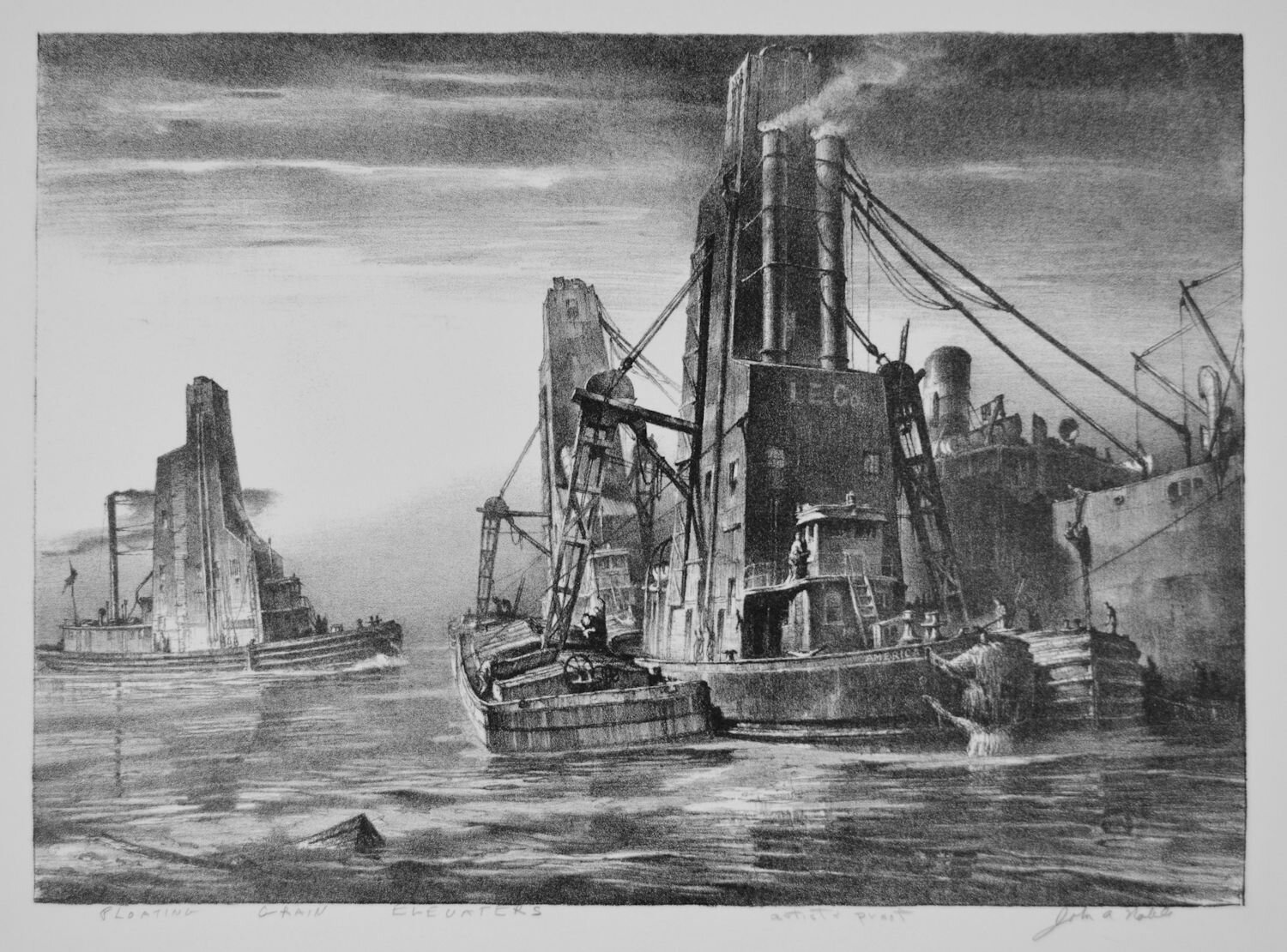
Grain Elevators of New York
Lithograph, 1951; edition of about 160. Image size 15-15/16” x 11½”; sheet size 20” x 16”. Titled, annotated “artist’s proof,” and signed by the artist in pencil in the lower margin. Commissioned by International Elevating Company, New York, the image depicts a pair of long-vanished floating grain elevators used in the harbors of the region to transfer the cargoes of arriving railroad grain barges to freighters bound for foreign ports. A fine impression in fine condition. Urban 23.
SOLD
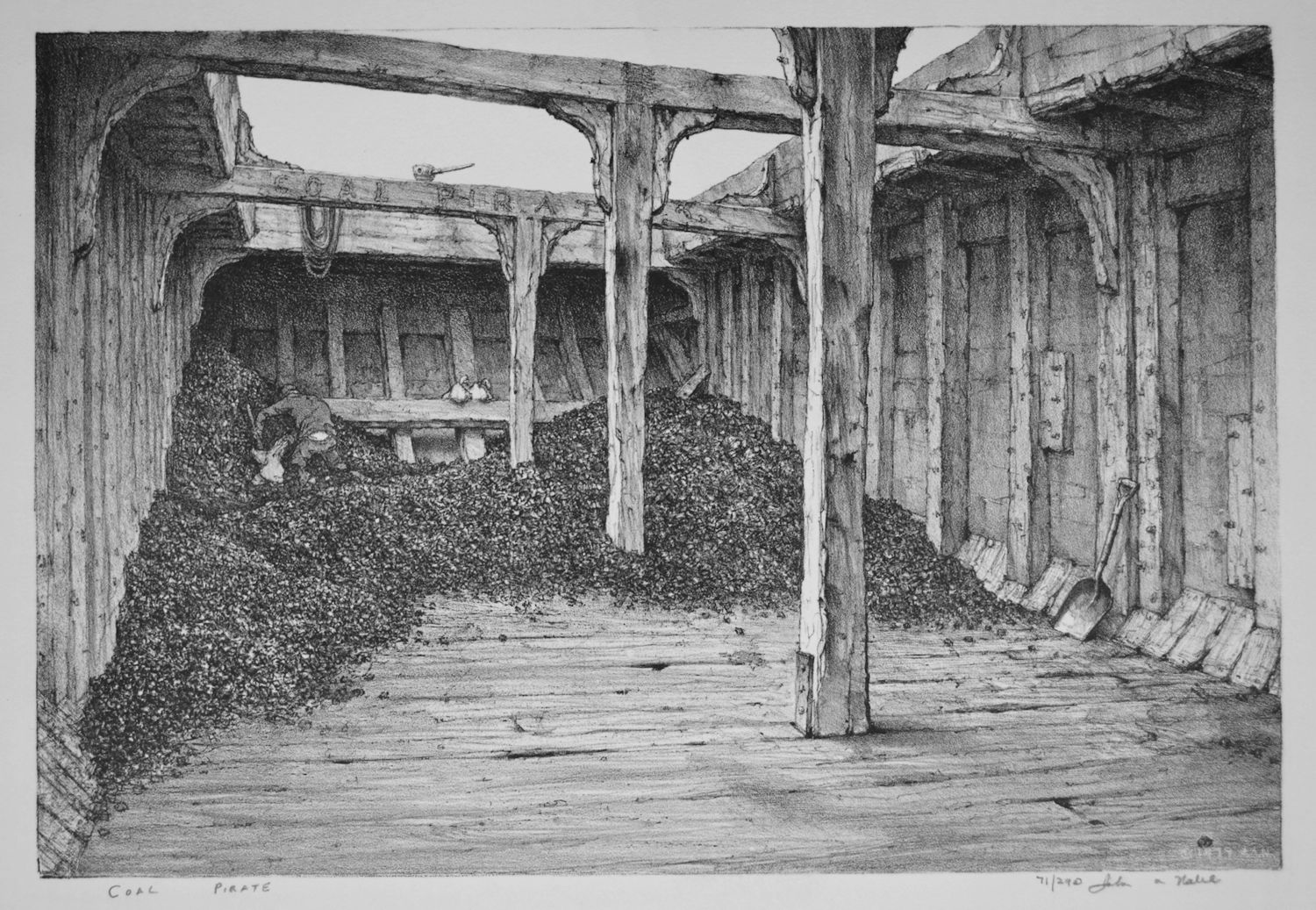
Coal Pirate
Lithograph on wove paper, 1979; edition of 290. Image size 17-5/16” x 11-3/4”; sheet size 21-1/4” x 16-1/2”. The coal barge was a scrupulously built if unadorned vessel.built of long-leaf yellow pine. Not long ago, it was a common sight in any working harbor. The remnants of its cargo provided enterprising scavengers with fuel for their potbellied office and workshop stoves. Here is one such entrepreneur taking his chances against the vigilance of the barge captain, asleep in the cabin on deck. A fine impression in fine condition. Urban 70.
$495
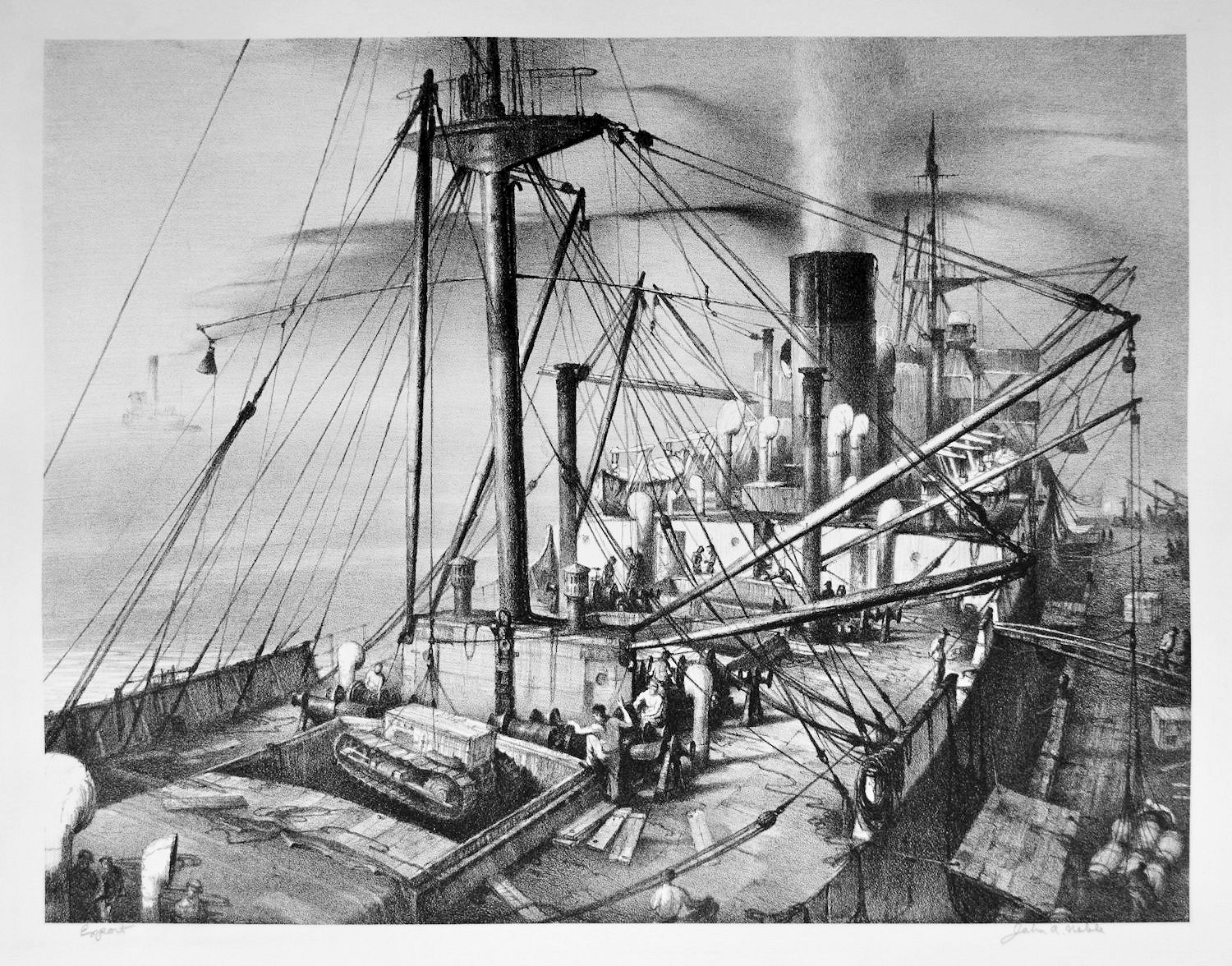
Export
Lithograph, 1951; edition of 200. Image size 15-5/8” x 12-1/16”; sheet size 17-3/4” x 14-5/8”. A beautiful impression in near-fine overall condition, commissioned by John T. Clark & Son, New York. It is based on Noble's original drawing made from the roof of the Bush Terminal pier at which the Ellerman Wilson Line's Consuelo was loading. This print is in the collection of The Mariners' Museum, New York. Urban #22, Ames #22. Titled and signed in pencil by the artist in the lower margin.
$575
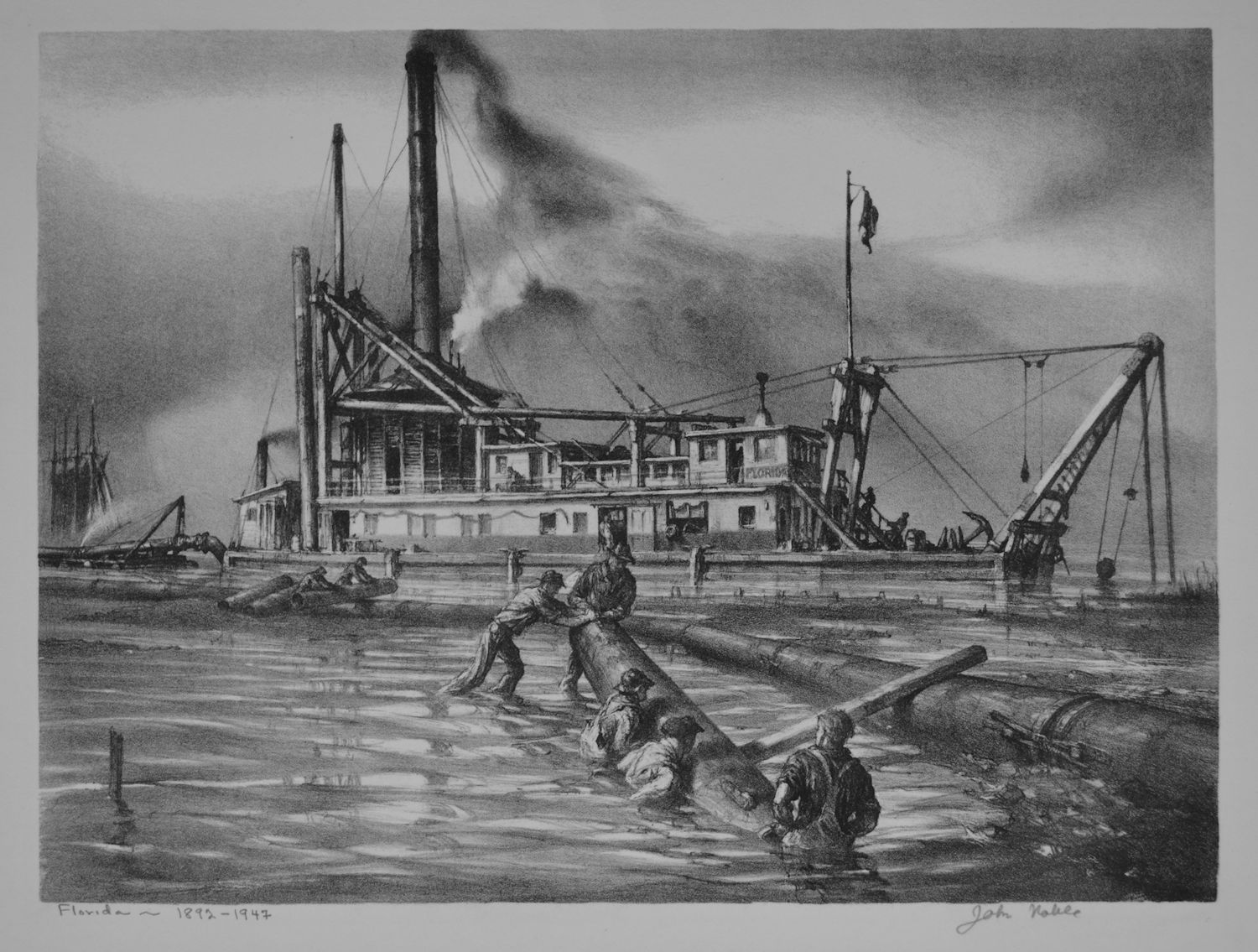
The Florida, 1892 - 1947
Lithograph on wove paper, 1964; edition ca. 150. Image size 15-13/16” x 11-3/4”’ sheet size 19-7/8” x 16-5/16”. The venerable dredge is pictured as she looked in her early years before the towering smokestack was removed. Among her other accomplishments, the Florida was employed in the construction of Port Newark, New Jersey during the first decades of the twentieth century. The lithograph was commissioned by Atlantic, Gulf and Pacific Company, New York, New York. Fine.
SOLD
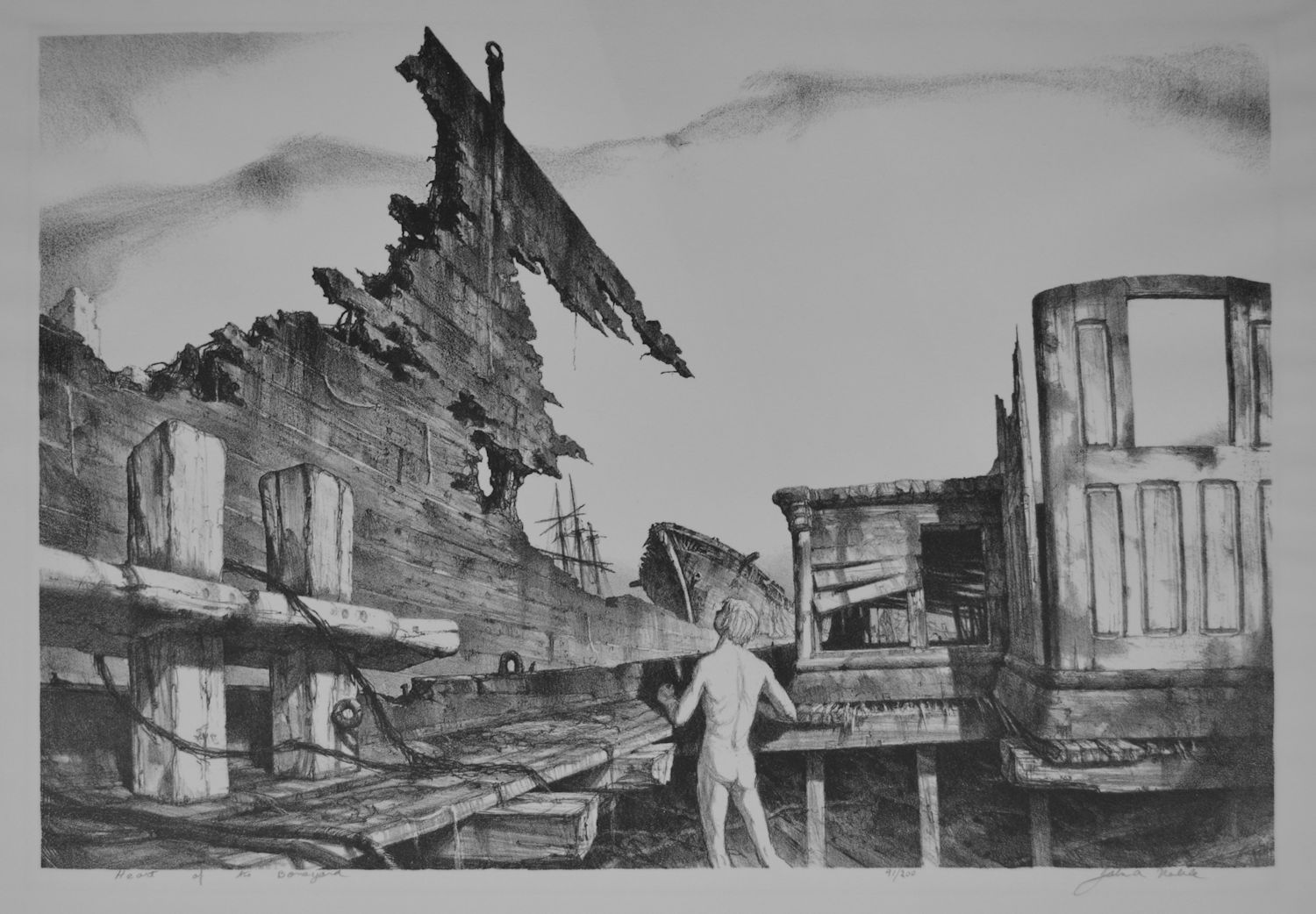
Heart of the Boneyard
Lithograph on wove paper, 1971; edition of 200. Image size 21-7/16” x 14-9/16”; sheet size 26” x 19-3/8”. In the artist’s account of this work, the scene is a microcosm of the Port Johnson boneyard at Bayonne, in its day the largest collection of derelict hulls on the East Coast. The naked young boy stands on the deck of a schooner surveying the adjaacent remains of an enormous wooden oil tanker of the World War I era. This image won the Cannon Prize, National Academy of Design, 147th Exhibition, February, 1972. Fine. Urban 61.
$1,100

Towing Out - End of Sail in the East River
Lithograph on wove paper, 1975; edition of 295. Image size 18” x 13-13/16”; sheet size 23” x 18-1/2”. “ © JAN” in stone; titled and signed in pencil by the artist in the lower margin. Plate No. 3 of “Downtown Trilogy”. Awarded the Henry LeGrand Cannon Prize at the 151st Annual Exhibition, National Academy of Design, February, 1976. Fine. Urban 66.
SOLD
